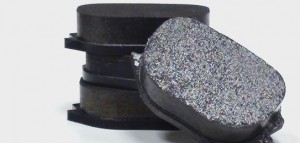

PFC Brake Bedding, how to do it and get the best out of your PFC brakes ?
Please follow the undernoted instructions for both PFC brake pads and discs.
For more information, please don't hesitate to contact RaceHardware.

Bedding New Performance Friction Brake Discs
Ensure that the brake discs are clean and free of grease or other contaminants.
Once the discs and pads are installed, perform the following procedure with brake cooling ducts fully open and functional - no tape! Best results are achieved using new Performance Friction brake pads. It is not necessary to bed in new PFC discs with used PFC pads.
On the first lap, perform several stops with progressively higher pedal pressure and braking force and from higher speeds. You will feel the effectiveness of the brakes increase with each successive stop. This should take six to ten brake stops per lap and is typically completed in one or two laps. As soon as the brakes become firm and responsive the car can be driven normally and at increased speeds. Running the car at speed for one or two more laps with allow the disc to achieve the desired core temperature. If three-colour rotor paints are used, the green paint should be fully changed and the orange paint beginning to change to white. A transfer layer of pad material will deposit on the disc; this is the slate gray colouration on the disc friction surface. This is a good indication that the disc and pads have been bedded properly.
Bedding New Performance Friction Brake Pads
Motorsport
If the discs were previously being used with Performance Friction pads, then the bedding procedure will be achieved quickly with new PFC pads. If the discs were previously bedded using a different manufacturer's pads then the process will take slightly longer. Again, with brake cooling ducts open and fully functional, perform the following procedures.
On the first lap, perform several stops with progressively higher pedal pressure and braking force and from higher speeds. You will feel the effectiveness of the brakes increase with each successive brake application. This should take 6 to 10 stops per lap and is usually completed in one or two laps. If non-PFC friction materials were previously run on the discs then this procedure could take as many as three to five laps. This is because the non-PFC friction material transfer layer must first be cleaned from the disc and then a fresh layer must be imparted to the disc.
Running additional laps is the best way to accomplish the new transfer layer and, due to the higher surface temperatures, will assure a complete removal of the old friction materials from the disc. Braking effectiveness should be excellent at this point and the car can be driven normally.
NOTE: Sanding/machine grinding the discs will not decrease the bedding time. Whenever new Performance Friction pads are installed, the pads require very little cool down time. Usually the time spent taking tyre temperatures and a debriefing with the driver is sufficient.
Powersports(Trackday)
Correct bedding in procedures can increase pad and disc life.
First, ensure the disc is clean and free from any other pad manufacturer's material before using our PFC pads. Other manufacturer's pads can leave an uneven transfer layer on the disc and cause bedding problems.
The rider should build temperature in the disc and pad gradually over approximately 4 laps. Once our PFC pads are fitted and the rider is ready, conduct an out lap at about 50% normal speed and apply brake pressure in the normal way. DO NOT keep a hold of the lever in an attempt to induce heat in the pads. This will thermally shock the pads and cause them to glaze.
Then conduct a further two laps progressively increasing the speed and level pressure. The fourth lap should be at full speed and normal brake pressure. The bike should then be brought into the pit, making sure to conduct at least two heavy brake applications with even brake pressure. This helps to create an even transfer layer of material on the disc. Then, let the brakes cool for at least 5 minutes. This ensures that the pads and discs have heat cycled in a controlled manner that helps prolong disc and pad life.
The brake pads are then ready to use at full race pace, remembering to generate heat into the pads on the out lap.
Having trouble after bedding in your brakes? see below common problems and solutions below;
Vibration
Check your disks for an uneaven transfer layer or large cracks
Not Stopping Effectivly
Pad could be glazed
Not an even or enough of a transfer layer yet - continue bedding
For more information regarding PFC Brakes, technical an sales: Please contact RaceHardware.